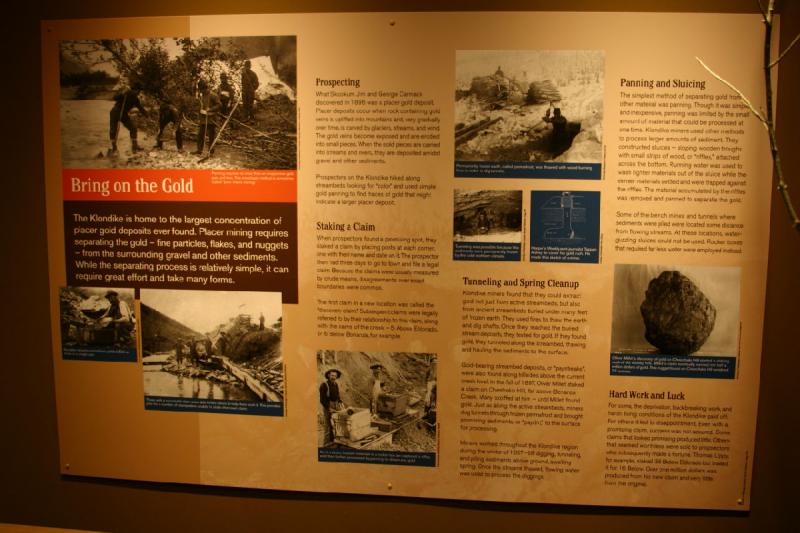 Album: Seattle, Washington 2007
Image: 502 / 545
Date: 2007-09-03 11:16:48
Tags: Seattle Bring on the Gold
The Klondike is home to the largest concentration of placer gold deposits ever found. Placer mining requires separating the gold - fine particles, flakes, and nuggets - from the surrounding gravel and other sediments. While the seperating process is relatively simple, it can require great effort and take many forms.
Prospecting
What Skookum Jim and George Carmack discovered in 1896 was a placer gold deposit. Placer deposits occur when rock containing gold veins is uplifted into mountains and, very gradually over time, is carved by glaciers, streams, and wind. The gold veins become exposed and are eroded into small pieces. When the solid pieces are carried into streams and rivers, they are deposited amidst gravel and other sediments.
Prospectors on the Klondike hiked along streambeds looking for "color" and used simple gold panning to find traces of gold that might indicate a larger placer deposit.
Staking a Claim
When prospectors found a promising spot, they staked a claim by placing posts at each corner, one with their name and date on it. The prospector then had three days to go to town and file a legal claim. Because the claims were usually measured by crude means, disagreements over exact boundaries were common.
The first claim in a new location was called the "discovery claim." Subsequent claims were legally referred to by their relationship to this claim, along with the name of the creek - 5 Above Eldorado, or 6 Below Bonanza, for example.
Tunneling and Spring Cleanup
Klondike miners found that they could extract gold not just from active streambeds, but also from ancient streambeds buried under many feet of frozen earth. They used fires to thaw the earth and dig shafts. Once they reached the buried stream deposits, they tested for gold. If they found gold, they tunneled along the streambed, thawing and hauling the sediments to the surface.
Gold-bearing streambed deposits, or "paystreaks", were also found along hillsides above the current creek level. In the fall of 1897, Oliver Millet staked a claim on Cheehako Hill, far above Bonanza Creek. Many scoffed at him - until Millet found gold. Just as along the active streambeds, miners dug tunnels through frozen permafrost and brought primising sediments, or "paydirt" to the surface for processing.
Miners worked throughout the Klondike region during the winter of 1897-98 digging, tunneling, and piling sediments above ground, awaiting spring. Once the streams thawed, flowing water was used to process the diggings.
Panning and Sluicing
The simplest method of separating gold from other material was panning. Though it was simple and inexpensive, panning was limited by the small amount of material that could be processed at one time. Klondike miners used other methods to process larger amounts of sediment. They constructed sluices - sloping wooden troughs with small strips of wood, or "riffles," attached across the bottom. Running water was used to wash lighter materials out of the sluice while the denser materials settled and were trapped against the riffles. The material accumulated by the riffles was removed and panned to seperate the gold.
Some of the bench mines and tunnels where sediments were piled were located some distance from flowing streams. At these locations, water-guzzing sluices could not be used. Rocker boxes that required far less water were employed instead.
Hard Work and Luck
For some, the deprivation, backbreaking work, and harsh living conditions of the Klondike paid off. For others it led to disappointment. Even with a promising claim, success was not assured. Some claims that looked promising produced little. Others that seemed worthless were sold to prospectors who subsequently made a fortune. Thomas Lippy, for example, staked 36 Below Eldorado but traded it for 16 Below. Over one million dollars was produced from his new claim and very little from the original. Exposure Time: 0.025 s (1/40)
Aperture: f/4.0
Sensitivity: 100 ISO
Focal Length: 28 mm
Make: Canon
Model: Canon EOS DIGITAL REBEL
Owner: Ruben Schoenefeld
Camera Number: 1560516904
Image Number: 1929300 |